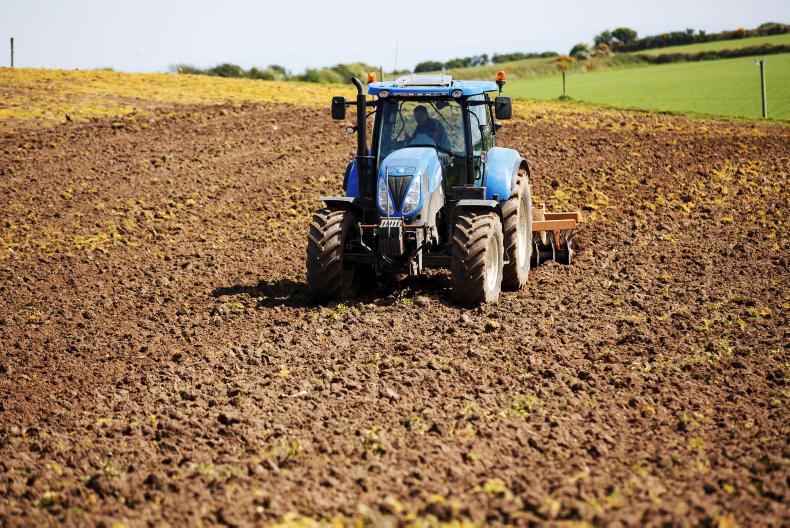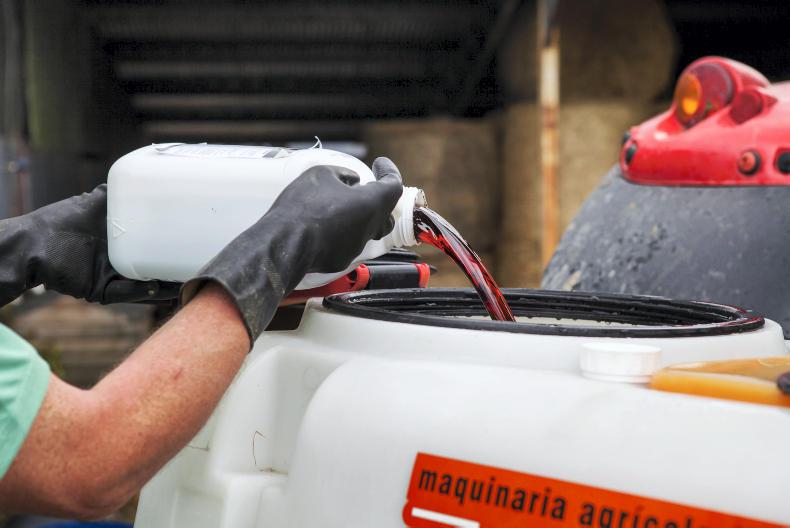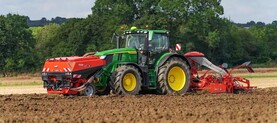At around €300/acre, reseeding is a significant investment on farms. The return from this investment is more grass.
Teagasc research shows there is a 3t/ha difference in annual grass growth from reseeding old permanent pasture swards. This is because you are replacing old swards with perennial ryegrass-dominated swards.
The other big benefit is in terms of fertiliser use efficiency, with nitrogen up to 25% more responsive when applied on perennial ryegrass-dominated swards. Between extra grass and better-quality grass, an extra 8% in milk output per hectare can be achieved on reseeded swards relative to old permanent pasture swards.
But these returns are only achieved when the reseeding job is done correctly. Too often, we hear stories from farmers of reseeding jobs that didn’t work out as well as planned. Sometimes, they get overrun by docks, sometimes a high proportion of the seeds fail to germinate, but more often than not, the biggest problem is the quick return of weed grasses into the sward. Most of these issues can be avoided if managed correctly. The following is a checklist of things to do to ensure a successful outcome when reseeding.
At around €26/acre for the cost of spraying and 2 litres/acre of glyphosate, it is a good investment. The advantage is that you are killing old grasses and weeds.
This means that whatever weeds emerge after sowing will be seedlings and much easier to kill. Without spraying off the old vegetation, weeds such as docks and weed grasses such as scutch will be a much bigger problem in the new sward.
You should give between five and seven days between spraying and removing the old vegetation. Some farmers decide to cut and bale the old grasses.
This gives a very clean residual, which is particularly good for min-till cultivation. The risk with baling is that the weather won’t be right when you want to cut.
Many farmers will say that you need to cut and bale it anyway, regardless of the weather. Grazing the sprayed-off grass is perfectly safe once you allow adequate time after spraying. Ideally, you want it grazed between five and seven days after spraying.
Match stock numbers to the area. There’s no point in putting in stock that will take a week to graze the area when you need it grazed off in two days.
Where there is a high dock infestation, two or three weeks should be left between spraying and cultivating to allow time for the tap root to die back. You will need to allow this much time for the thrash to die back when using min-till methods anyway.
Decaying leaves and thrash from the previous sward cause surface acidity.
This is an issue when using min-till techniques such as one-pass, discing, Guttler, Einboch or slot seeders. It is less of an issue when ploughing as the thrash is buried.
So, when using min-till techniques, about 2t/acre of lime should be applied prior to cultivation to neutralise the acidity.
Reseeding is a good opportunity to fix soil acidity anyway. If ploughing, apply lime to the ploughed ground and work it in.
Don’t get too hung up about cultivation methods.
All methods work well when done correctly. The key point with ploughing is not to plough too deep. Shallow ploughing at 6in or less is ideal. The issue with ploughing is stones. Min-till methods can overcome such problems.

When discing, drive slowly and give it two or three runs in angled directions. When using a one-pass, drive very slowly. When using a direct drill, Einboch, Guttler or slot seeder you should apply slug pellets and wait for moist conditions so the ground will cut up a bit. Do not use when ground is dry and hard.
Roll after all sowing methods. The net result should be a fine, firm and level seedbed which you can ride a bicycle over.
Two soil tests are required when reseeding. The first soil test should be taken the winter before reseeding and the next soil test shoould be taken the winter after reseeding. Don’t assume soils are at Index 3.
Perennial ryegrass needs soils at optimum pH and phosphorus (P) and potassium (K) levels for good growth. Without this, new reseeds will never achieve their potential.
Well-fertilised reseeds will enable the new sward to outcompete weeds and weed grasses.
One of the main reasons why many reseeds revert back to weed grass swards quickly is because of poor soil fertility. All soils need 30 units/acre of nitrogen at sowing.
Soils at Index 3 will need 24 units of P and 40 units of K at sowing. Phosphorus is essential for growth and development but is not very mobile in the soil so it should be applied prior to sowing and worked into the seedbed.
Soil test the following winter to check levels again. This is very important after ploughing as the turned-up soil could be lower in soil fertility.
Keep an eye on new reseeds for signs of pests. The common pests are slugs (particularly when using slot seeders and in wet/damp conditions).
Shredded leaves indicate slugs.
Slugs tend to attack from the headlands out. A fine firm seedbed is a good prevention. If slugs are suspected, slug pellets can be applied.
Leatherjackets are another problem on heavy/wet land with no chemical control.
Rolling a firm and level seedbed is a control method, as is giving seeds the best possible chance after emergence.
Frit fly is a problem in autumn and is observed by the centre shoot turning yellow and dying.
The post-emergence spray is a critical part of the whole process.
Killing weeds at the seedling stage is by far the most effective time to do so.
What type of spray to use depends on whether or not clover was sown with the grass seed. If it was, only clover-safe sprays should be used.
These tend to be a little more expensive than the non-clover safe. The ideal time to spray is when the dock seedlings are around the size of a €2 coin.
Don’t let the new reseeds go to silage. Graze a few times before closing for silage.
The first grazing should be complete at a very light cover, just heavy enough to avoid the animals pulling the roots with the leaves. Ideally, this grazing should be done with cows to get good grazing pressure over a short time.
Repeat again after 14 days. Regular grazing at light covers will help the grass plant to tiller and outcompete other grasses and weeds.
Read more
How to pick a grass seed variety
In pictures: reseeding demonstration revisited
Full coverage of the 2017 reseeding focus
At around €300/acre, reseeding is a significant investment on farms. The return from this investment is more grass.
Teagasc research shows there is a 3t/ha difference in annual grass growth from reseeding old permanent pasture swards. This is because you are replacing old swards with perennial ryegrass-dominated swards.
The other big benefit is in terms of fertiliser use efficiency, with nitrogen up to 25% more responsive when applied on perennial ryegrass-dominated swards. Between extra grass and better-quality grass, an extra 8% in milk output per hectare can be achieved on reseeded swards relative to old permanent pasture swards.
But these returns are only achieved when the reseeding job is done correctly. Too often, we hear stories from farmers of reseeding jobs that didn’t work out as well as planned. Sometimes, they get overrun by docks, sometimes a high proportion of the seeds fail to germinate, but more often than not, the biggest problem is the quick return of weed grasses into the sward. Most of these issues can be avoided if managed correctly. The following is a checklist of things to do to ensure a successful outcome when reseeding.
At around €26/acre for the cost of spraying and 2 litres/acre of glyphosate, it is a good investment. The advantage is that you are killing old grasses and weeds.
This means that whatever weeds emerge after sowing will be seedlings and much easier to kill. Without spraying off the old vegetation, weeds such as docks and weed grasses such as scutch will be a much bigger problem in the new sward.
You should give between five and seven days between spraying and removing the old vegetation. Some farmers decide to cut and bale the old grasses.
This gives a very clean residual, which is particularly good for min-till cultivation. The risk with baling is that the weather won’t be right when you want to cut.
Many farmers will say that you need to cut and bale it anyway, regardless of the weather. Grazing the sprayed-off grass is perfectly safe once you allow adequate time after spraying. Ideally, you want it grazed between five and seven days after spraying.
Match stock numbers to the area. There’s no point in putting in stock that will take a week to graze the area when you need it grazed off in two days.
Where there is a high dock infestation, two or three weeks should be left between spraying and cultivating to allow time for the tap root to die back. You will need to allow this much time for the thrash to die back when using min-till methods anyway.
Decaying leaves and thrash from the previous sward cause surface acidity.
This is an issue when using min-till techniques such as one-pass, discing, Guttler, Einboch or slot seeders. It is less of an issue when ploughing as the thrash is buried.
So, when using min-till techniques, about 2t/acre of lime should be applied prior to cultivation to neutralise the acidity.
Reseeding is a good opportunity to fix soil acidity anyway. If ploughing, apply lime to the ploughed ground and work it in.
Don’t get too hung up about cultivation methods.
All methods work well when done correctly. The key point with ploughing is not to plough too deep. Shallow ploughing at 6in or less is ideal. The issue with ploughing is stones. Min-till methods can overcome such problems.

When discing, drive slowly and give it two or three runs in angled directions. When using a one-pass, drive very slowly. When using a direct drill, Einboch, Guttler or slot seeder you should apply slug pellets and wait for moist conditions so the ground will cut up a bit. Do not use when ground is dry and hard.
Roll after all sowing methods. The net result should be a fine, firm and level seedbed which you can ride a bicycle over.
Two soil tests are required when reseeding. The first soil test should be taken the winter before reseeding and the next soil test shoould be taken the winter after reseeding. Don’t assume soils are at Index 3.
Perennial ryegrass needs soils at optimum pH and phosphorus (P) and potassium (K) levels for good growth. Without this, new reseeds will never achieve their potential.
Well-fertilised reseeds will enable the new sward to outcompete weeds and weed grasses.
One of the main reasons why many reseeds revert back to weed grass swards quickly is because of poor soil fertility. All soils need 30 units/acre of nitrogen at sowing.
Soils at Index 3 will need 24 units of P and 40 units of K at sowing. Phosphorus is essential for growth and development but is not very mobile in the soil so it should be applied prior to sowing and worked into the seedbed.
Soil test the following winter to check levels again. This is very important after ploughing as the turned-up soil could be lower in soil fertility.
Keep an eye on new reseeds for signs of pests. The common pests are slugs (particularly when using slot seeders and in wet/damp conditions).
Shredded leaves indicate slugs.
Slugs tend to attack from the headlands out. A fine firm seedbed is a good prevention. If slugs are suspected, slug pellets can be applied.
Leatherjackets are another problem on heavy/wet land with no chemical control.
Rolling a firm and level seedbed is a control method, as is giving seeds the best possible chance after emergence.
Frit fly is a problem in autumn and is observed by the centre shoot turning yellow and dying.
The post-emergence spray is a critical part of the whole process.
Killing weeds at the seedling stage is by far the most effective time to do so.
What type of spray to use depends on whether or not clover was sown with the grass seed. If it was, only clover-safe sprays should be used.
These tend to be a little more expensive than the non-clover safe. The ideal time to spray is when the dock seedlings are around the size of a €2 coin.
Don’t let the new reseeds go to silage. Graze a few times before closing for silage.
The first grazing should be complete at a very light cover, just heavy enough to avoid the animals pulling the roots with the leaves. Ideally, this grazing should be done with cows to get good grazing pressure over a short time.
Repeat again after 14 days. Regular grazing at light covers will help the grass plant to tiller and outcompete other grasses and weeds.
Read more
How to pick a grass seed variety
In pictures: reseeding demonstration revisited
Full coverage of the 2017 reseeding focus







 This is a subscriber-only article
This is a subscriber-only article










SHARING OPTIONS: